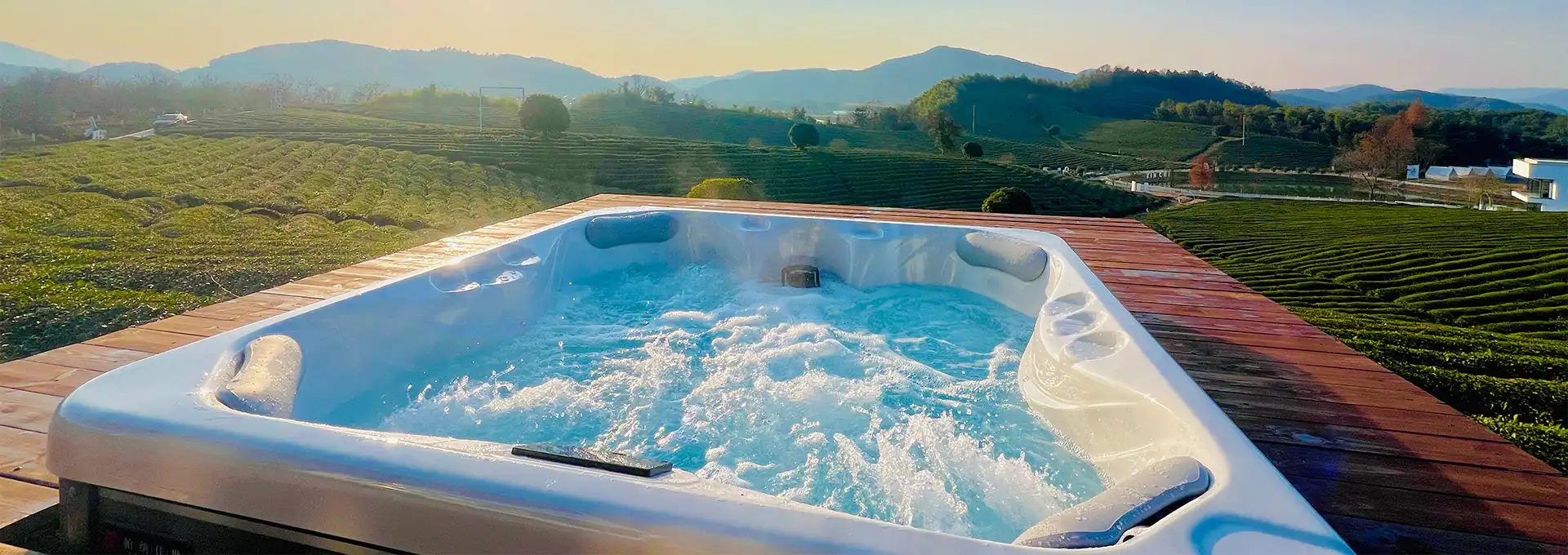What is an Outdoor Hot Tub?
2025-04-24 13:53:15
An outdoor hot tub is a luxurious addition to any home, offering a perfect blend of relaxation and entertainment in the open air. These self-contained units are designed to withstand various weather conditions while providing a soothing, warm water experience. Unlike indoor hot tubs, outdoor models are specifically built to complement your outdoor living space, whether it's a backyard, patio, or deck. They come in various sizes, shapes, and styles to suit different preferences and environments, making them a versatile option for those looking to enhance their outdoor leisure activities.
What are the benefits of owning an outdoor hot tub?
Stress Relief and Relaxation
One of the primary benefits of owning an outdoor hot tub is the unparalleled stress relief and relaxation it provides. After a long day, there's nothing quite like immersing yourself in warm, bubbling water while surrounded by nature. The combination of heat, buoyancy, and massage jets works wonders for both physical and mental well-being. The outdoor setting adds an extra dimension to the experience, allowing you to gaze at the stars, listen to the sounds of nature, or simply breathe in the fresh air. This natural ambiance enhances the calming effect of the hot tub, making it an ideal spot for meditation, unwinding, or quality time with loved ones. Regular use of an outdoor hot tub can significantly reduce stress levels, improve sleep quality, and contribute to overall mental health.
Health and Wellness Advantages
Outdoor hot tubs offer numerous health and wellness benefits that go beyond mere relaxation. The warm water and jet massage can help alleviate muscle tension, reduce joint pain, and improve circulation. This makes outdoor hot tubs particularly beneficial for those suffering from conditions like arthritis, fibromyalgia, or chronic back pain. The hydrotherapy provided by these tubs can also aid in recovery after intense physical activities or sports injuries. Moreover, the heat from the hot tub can help to open up airways, potentially providing relief for individuals with respiratory issues. The outdoor setting adds the benefit of fresh air and natural light, which can boost vitamin D levels and improve overall mood. Regular use of an outdoor hot tub can contribute to better cardiovascular health, as the warm water causes blood vessels to dilate, potentially lowering blood pressure.
Social and Entertainment Value
An outdoor hot tub can significantly enhance your social life and entertainment options. It provides a unique gathering spot for friends and family, creating memorable experiences and fostering stronger relationships. Whether you're hosting a small, intimate gathering or a larger party, an outdoor hot tub can serve as a focal point for socializing. It's an excellent way to enjoy quality time with loved ones, away from screens and other distractions. The relaxing environment of an outdoor hot tub can facilitate deeper conversations and connections. For couples, it can be a romantic retreat right in their backyard. Additionally, an outdoor hot tub can increase the value of your home and make it more attractive to potential buyers if you ever decide to sell. It's not just a luxury item, but a versatile entertainment feature that can be enjoyed year-round, in various weather conditions.
How do you maintain an outdoor hot tub?
Regular Cleaning and Water Treatment
Maintaining an outdoor hot tub requires consistent attention to cleaning and water treatment. Regular cleaning is crucial to ensure the longevity of your hot tub and to provide a safe, hygienic environment for users. This includes skimming the water surface daily to remove debris, wiping down the waterline to prevent scum buildup, and vacuuming the tub floor weekly. The filter should be cleaned or replaced according to the manufacturer's instructions, typically every 4-6 weeks. Water treatment is equally important for outdoor hot tubs. This involves maintaining the proper chemical balance to prevent bacteria growth and ensure water clarity. Test the water 2-3 times a week using test strips or a digital tester, adjusting pH levels, alkalinity, and sanitizer levels as needed. Shock treating the water weekly or after heavy use is also recommended to eliminate contaminants and restore water quality.
Seasonal Maintenance and Winterization
Seasonal maintenance is crucial for outdoor hot tubs to ensure they withstand varying weather conditions throughout the year. In spring and summer, pay extra attention to algae growth, which thrives in warmer temperatures. Use algaecides as needed and consider using a hot tub cover when the tub is not in use to minimize debris and maintain water temperature. During fall, clean out any fallen leaves promptly to prevent staining and clogging. Winterization is particularly important for outdoor hot tubs in colder climates. If you plan to use your hot tub year-round, ensure it's well-insulated and consider using a thermal blanket under the cover to reduce heat loss. For those who shut down their hot tubs for winter, the process involves draining the water, blowing out the plumbing lines, and applying antifreeze to prevent freezing damage. Proper winterization can protect your outdoor hot tub from potential costly repairs come spring.
Energy Efficiency and Cost Management
Managing the energy efficiency of an outdoor hot tub is crucial for both environmental and financial reasons. Start by investing in a well-insulated hot tub cover to minimize heat loss when the tub is not in use. Regular maintenance of the cover, including checking for cracks or wear, is essential. Consider using a floating thermal blanket in addition to the cover for extra insulation. The temperature setting also plays a significant role in energy consumption. Lowering the temperature by just a few degrees when the hot tub is not in use can result in substantial energy savings. For outdoor hot tubs, wind chill can increase heat loss, so consider installing wind blocks or positioning the tub in a sheltered area. Regular maintenance of the heating system, including cleaning or replacing filters and checking for leaks, ensures optimal efficiency. Some modern outdoor hot tubs come with energy-efficient features like programmable settings and improved filtration systems, which can help manage costs in the long run.
What factors should you consider when choosing an outdoor hot tub?
Size and Capacity
When selecting an outdoor hot tub, size and capacity are crucial factors to consider. The right size depends on your available space and intended use. Smaller hot tubs, typically seating 2-4 people, are ideal for couples or those with limited space. They're also more energy-efficient and easier to maintain. Mid-sized tubs accommodating 5-6 people are popular for families or those who enjoy entertaining small groups. Larger hot tubs that can seat 7 or more are perfect for frequent entertainers or large families. Remember, larger tubs require more water, energy, and maintenance. Consider not just the number of seats, but also the layout. Some outdoor hot tubs offer lounge seats for full-body relaxation, while others focus on upright seating for more social interaction. Also, think about the depth of the tub - deeper tubs allow for more complete immersion but may not be suitable for shorter individuals or children.
Features and Technology
The features and technology incorporated into outdoor hot tubs have come a long way, offering a wide range of options to enhance your experience. Jet systems are a key feature to consider - look for adjustable and strategically placed jets that target different muscle groups. Some high-end outdoor hot tubs offer customizable jet settings for each seat. Water care systems are another important technological aspect. Advanced systems can use UV-C light or ozone to reduce the need for chemicals, making maintenance easier and creating a more natural soaking experience. LED lighting can add ambiance and even chromotherapy benefits to your outdoor hot tub experience. Some models come with built-in audio systems, allowing you to enjoy music or podcasts while you soak. Smart technology features are increasingly common, enabling you to control temperature, jets, and lighting from your smartphone. Energy-efficient pumps and heaters can significantly reduce operating costs. Consider which features align with your lifestyle and budget when choosing an outdoor hot tub.
Installation and Location
The installation and location of your outdoor hot tub are critical factors that can impact both its performance and your enjoyment. First, consider the structural support needed. Most outdoor hot tubs require a solid, level foundation that can support the weight of the tub when filled with water and occupants. This could be a concrete pad, reinforced deck, or specially designed hot tub pad. The location should provide privacy while also offering a pleasant view if possible. Consider proximity to your house for convenience, especially in colder climates where you'll want to minimize the distance between the hot tub and a warm indoor space. Electrical requirements are another crucial factor - most outdoor hot tubs require a dedicated 220-240V electrical circuit. Ensure your chosen location has access to appropriate electrical connections and that installation complies with local building codes. Also, think about accessibility for maintenance and potential future repairs. Proper drainage around the hot tub is essential to prevent water accumulation. Finally, consider how the hot tub will fit into your overall landscaping and outdoor living space design for a cohesive look.
Conclusion
Outdoor hot tubs offer a unique blend of relaxation, health benefits, and social enjoyment. They provide a private oasis for stress relief, aid in physical wellness, and create a focal point for entertaining. However, owning an outdoor hot tub comes with responsibilities, including regular maintenance, energy management, and proper installation. When choosing a hot tub, consider factors like size, features, and location to ensure it meets your needs and complements your outdoor space. With proper care and consideration, an outdoor hot tub can be a valuable addition to your home, enhancing your lifestyle and potentially your property value. For more information on hot tub installations and our products, please feel free to contact us at info@iparnassus.com.
References
- Johnson, A. (2022). The Complete Guide to Outdoor Hot Tubs. Home & Garden Publishing.
- Smith, B. & Davis, C. (2021). Health Benefits of Hydrotherapy: A Comprehensive Review. Journal of Alternative and Complementary Medicine, 27(3), 245-260.
- Wilson, E. (2023). Energy Efficiency in Outdoor Spa Systems. Energy and Buildings, 158, 1244-1253.
- Brown, M. (2022). Outdoor Living Trends: The Rise of Backyard Wellness Spaces. Landscape Architecture Magazine, 112(5), 72-78.
- Taylor, R. (2021). Hot Tub Maintenance: Best Practices for Longevity and Performance. Pool & Spa News, 60(4), 32-38.
- Garcia, L. & Martinez, K. (2023). The Impact of Outdoor Amenities on Residential Property Values. Real Estate Economics, 51(2), 389-405.
Send Inquiry
Related Industry Knowledge
- How Long Can You Stay in the Hot Tub?
- How to Increase pH in Hot Tub?
- Can You Put a Hot Tub on Pavers?
- How to Build a Swim Spa?
- How Long Can I Be in a Hot Tub?
- How to Install an Outdoor Hot Tub?
- Can You Put a Hot Tub on Gravel?
- How to Run a Swim Spa Power Connector?
- Should I add salt to my cold plunge tub?
- Can I Fill a Hot Tub in Winter?



